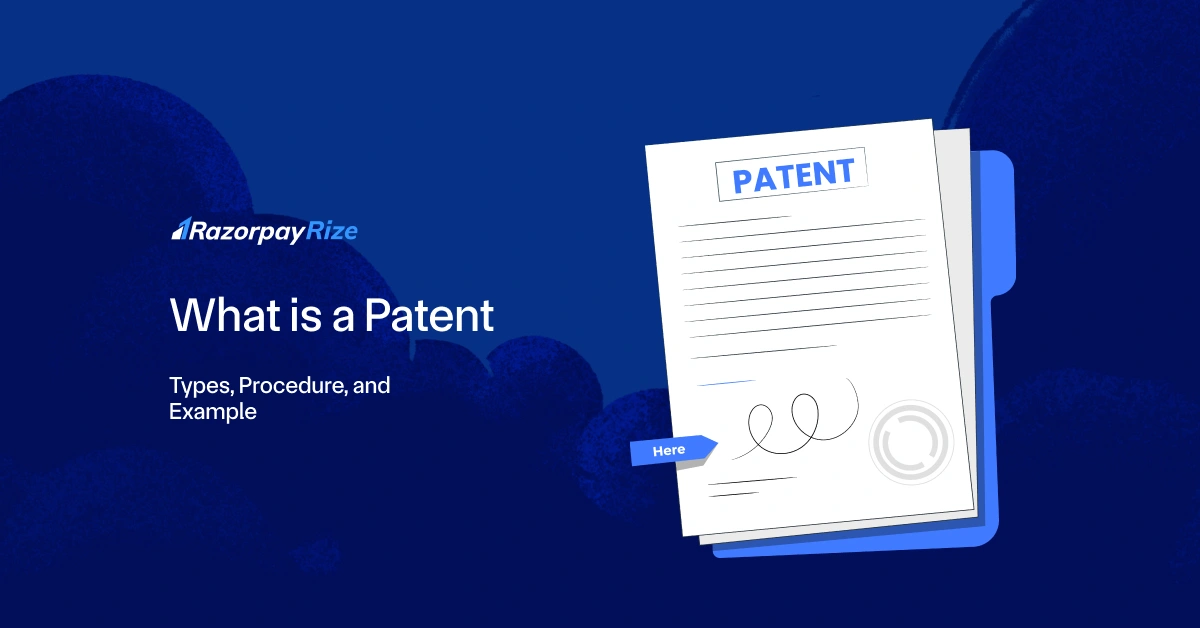In a world driven by innovation, protecting intellectual property is critical, not just for inventors but also for the advancement of science, technology, and industry as a whole. Patents are a powerful tool for safeguarding inventions, offering exclusive commercial rights, and encouraging investment in new ideas.
In this comprehensive guide, we’ll explore patents, the different types available, the filing process in India, what qualifies (and what doesn’t), and notable real-world examples.
Table of Contents
What is a Patent?
A patent is a legal right granted by a government authority to an inventor or assignee. It provides exclusive rights to make, use, sell, or license the invention for a fixed period, typically 20 years from the filing date (in the case of utility patents).
In India, patents are granted by the Indian Patent Office under the Indian Patent Act, 1970. Once granted, the patent gives the owner the legal authority to prevent others from commercially using the invention without consent.
In simple terms, a patent:
- Protects original inventions
- Offers a time-bound monopoly
- Encourages innovation by offering a return on investment
Types of Patent
There are three main types of patents recognised globally (India primarily follows the utility patent framework):
1. Utility Patent
Covers new processes, machines, or compositions. These are the most common patents.
Example: A new smartphone battery technology.
Protection Duration: 20 years from the filing date.
2. Design Patent
Protects the unique visual appearance of an object, not its function.
Example: The contour design of a Coca-Cola bottle.
Protection Duration: 15 years (in countries where design patents are recognised separately).
3. Plant Patent
Covers new, asexually reproduced plant varieties.
Example: A genetically modified rose variety.
Protection Duration: 20 years (not commonly filed in India).
Related Read: Types of Patent
Types of Patent Applications
In India, there are four primary types of patent applications, each serving a distinct purpose:
1. Provisional Application
A temporary application filed to secure a priority date while the invention is still being finalised. It is valid for 12 months (must file a complete specification within this period).
2. Complete Application
It contains the full invention description, claims, and drawings. Can be filed directly or after a provisional application. It's the final and examinable document.
3. Divisional Application
It is filed when a single application contains multiple inventions. It allows the applicant to split them into separate applications while retaining the same priority date.
4. Additional Application
It is filed for improvements or modifications of an already filed invention. It must be linked to the main patent and cannot stand alone.
Turn your innovative idea into a registered business. Start your company registration today and protect your intellectual property from day one.
Importance of a Patent
Patents are more than just legal documents; they are strategic assets for innovation-driven businesses. Here’s why they matter:
- Protects Innovation: Prevents unauthorised use or duplication of your invention.
- Drives Research: Encourages R&D by granting exclusivity.
- Public Disclosure: Adds to the pool of technical knowledge through public databases.
- Market Advantage: Offers a monopoly that helps recover R&D investments.
- Licensing Revenue: Can be monetised via licensing deals or sales.
- Investor Confidence: Adds credibility and attracts funding.
- Eligibility for Government Support: Many startup schemes and grants favour IP-holding firms.
What Can Be a Patent?
Under Indian law, an invention is patentable if it meets the following criteria:
- Novelty: It must be new and not disclosed anywhere else.
- Inventive Step: It must involve technical advancement or economic significance.
- Industrial Applicability: It should be capable of being made or used in an industry.
Patentable Categories:
- Processes (e.g., water purification method)
- Machines (e.g., robotic arms)
- Articles of Manufacture (e.g., ergonomic chairs)
- Compositions of Matter (e.g., pharmaceutical formulations)
- Improvements on existing inventions (e.g., a faster version of a known algorithm)
What Cannot Be Patented?
Under Sections 3 and 4 of the Indian Patent Act, certain inventions are not patentable, even if they are novel.
Key Exclusions:
- Frivolous or contrary to natural laws (e.g., perpetual motion machine)
- Scientific theories or mathematical methods
- Methods of agriculture or horticulture
- Traditional knowledge (e.g., turmeric for healing wounds)
- Medical treatments or surgical methods
- Business methods or algorithms
- Mental acts or abstract ideas
- Atomic energy-related inventions (under Section 4)
These exclusions maintain ethical, cultural, and practical boundaries in IP law.
Patent Examples
Here are a few real-world patent examples that transformed industries:
- Wright Brothers' Airplane (1906):
The first powered aircraft patent. Paved the way for modern aviation. - Apple’s Slide-to-Unlock (2009):
A design feature that defined smartphone interaction. - Pfizer’s Lipitor (1993):
A cholesterol-lowering drug that became one of the best-selling medications. - Dyson Vacuum Cleaner (1986):
Innovative cyclone technology with no loss of suction.
How Much Does a Patent Cost in India?
The total cost of obtaining a patent in India varies based on complexity, legal support, and the size of the entity. The cost includes:
- Government Fees
- Professional Charges
- Examination Request Fee
- Additional Costs: Translation, drawings, office actions, renewals
Patent protection lasts for 20 years, subject to annual renewal fees after grant.
Content of a Patent
A patent document includes several structured sections that describe and define the invention:
- Title of the Invention
- Bibliographic Details (applicant name, filing date, etc.)
- Background / Prior Art
- Detailed Description (technical specifications and working)
- Drawings or Diagrams
- Claims
Unlike academic writing, patent specifications are precise, technical, and legal in tone. Many researchers prepare their own drafts, but expert assistance ensures compliance with formal requirements and claim strength.
Procedure for Getting a Patent in India
Here’s a step-by-step overview of the Indian patent filing process:
- Document the Invention: Maintain detailed records, diagrams, and experimental data.
- Conduct a Patent Search: To check if similar inventions exist.
- Draft a Provisional or Complete Specification.
- File the Application at the Indian Patent Office (offline or online).
- Publication: The application is published after 18 months unless early publication is requested.
- Request for Examination (RFE): Must be filed within 48 months.
- Examination Report & Objections: Respond to objections and make amendments, if needed.
- Grant of Patent: If approved, the patent is granted and published in the journal.
- Renewals: Pay annual renewal fees to maintain validity.
Difference Between Patents vs. Trademarks vs. Copyrights
Frequently Asked Questions
Private Limited Company
(Pvt. Ltd.)
- Service-based businesses
- Businesses looking to issue shares
- Businesses seeking investment through equity-based funding
Limited Liability Partnership
(LLP)
- Professional services
- Firms seeking any capital contribution from Partners
- Firms sharing resources with limited liability
One Person Company
(OPC)
- Freelancers, Small-scale businesses
- Businesses looking for minimal compliance
- Businesses looking for single-ownership
Private Limited Company
(Pvt. Ltd.)
- Service-based businesses
- Businesses looking to issue shares
- Businesses seeking investment through equity-based funding
One Person Company
(OPC)
- Freelancers, Small-scale businesses
- Businesses looking for minimal compliance
- Businesses looking for single-ownership
Private Limited Company
(Pvt. Ltd.)
- Service-based businesses
- Businesses looking to issue shares
- Businesses seeking investment through equity-based funding
Limited Liability Partnership
(LLP)
- Professional services
- Firms seeking any capital contribution from Partners
- Firms sharing resources with limited liability
Frequently Asked Questions
What do you mean by patent?
A patent is a legal right granted by a government to an inventor or assignee, giving them exclusive rights to make, use, sell, or license an invention for a limited period—typically 20 years from the date of filing. In exchange, the inventor must publicly disclose the details of the invention, contributing to scientific and technological knowledge.
What is a patent example?
Here are a few well-known examples of patented inventions:
- Apple’s Slide-to-Unlock Feature (U.S. Patent No. 8,046,721): A widely recognised software patent that changed the way users interact with touchscreens.
- Pfizer’s Patent for Lipitor (U.S. Patent No. 4,681,893): Protected the formula for a cholesterol-lowering drug that became a blockbuster medication.
Which Act governs the patent system in India?
The Indian patent system is governed by the Patents Act, 1970, along with the Patent Rules, 2003 (as amended). The Act defines what is patentable, outlines the procedure for filing and examination, and specifies the rights and obligations of patent holders.
The Controller General of Patents, Designs & Trade Marks (CGPDTM) oversees the administration and granting of patents through the Indian Patent Office.
Who can apply for a patent?
A patent application can be filed by:
- The true and first inventor (the person who actually created the invention)
- An assignee of the inventor (such as a company, research institution, or employer)
- A legal representative of a deceased inventor
In India, individuals, startups, small entities, educational institutions, and large companies can all apply for patents. Joint applications by multiple inventors or co-assignees are also permitted.
















